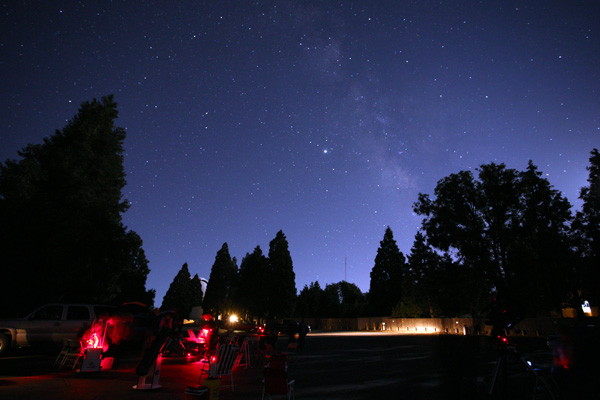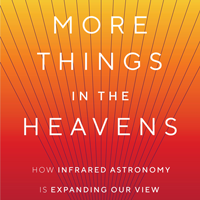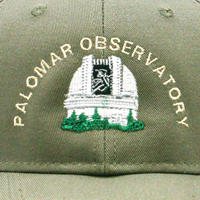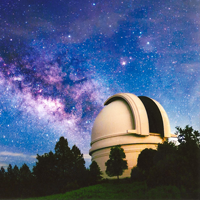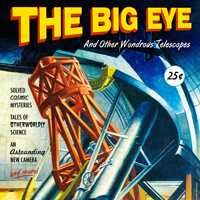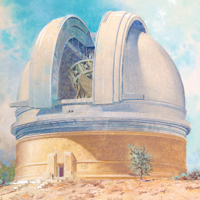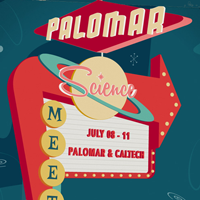Friends of Palomar Observatory Website
Upcoming Events

The Newsletter of the Friends of Palomar Observatory, Vol. 10 No. 1 – May 2015
Imaging Exoplanets
By Steve Flanders
Seeing Planets Like Never Before (2014). Documentary on finding exoplanets by the AMNH-led Project 1640 using the Hale Telescope. Duration: 9 minutes. (© AMNH).
In the period from the beginning of February to the end of July 2015, 23% of the available observing time on the Hale Telescope is or will be given to investigations related to the study of exoplanets—planets that orbit a star other than the Sun.
One reason these inquiries are given such prominence is that scientists wish to develop an increasingly comprehensive list of what types of planets exist in the universe. The Solar System provides only a few examples and the place where we live may or may not be representative of the multitude of planetary systems that likely exist out in our galaxy.
The first exoplanet orbiting a Sun-like star was found in 1995 by measuring the slight wobbles the planet’s mass induces in the motions of the host star, 51 Pegasi. This is referred to as the spectroscopic radial velocity method.
Many more exoplanets have been found since then. At the beginning of April 2015, Caltech and NASA listed 1,827 confirmed exoplanets with a larger list of candidate objects waiting further investigation. Caltech and NASA list 4,604 suspected exoplanets, the majority of which were identified in the data collected by the Kepler mission (up-to-date statistics are available from the New Worlds Atlas).
The Kepler mission has used the transit method of exoplanet detection. Now in a somewhat modified form, Kepler continues to use this method in its efforts to map the neighborhoods of stars beyond our own.
Originally watching one patch of sky in the constellation Cygnus for months at a time, the instruments on the Kepler spacecraft looked for periodic dips in the light of any of the stars within its field of view. During its six-year primary mission, the observatory found a long list of stars having light curves that could indicate the presence of one or more orbiting planets.
The difficulty in this data is that the light reductions are very, very small. During the transit of an exoplanet, the light loss may be as little as 0.01% of the host star’s total output. And there is uncertainty in this—such a small dimming could be an artifact of variations in the telescope’s optical system or due to some other incidental cause.
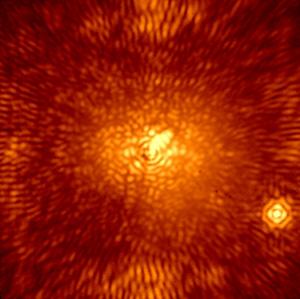
HR 8799 planetary system as imaged by P1640 after adaptive optics correction, coronagraph occultation, and wavefront calibration. The star light is suppressed, enabling the faint companion on the right to be seen. (P1640/AMNH/Palomar)
Similarly, there are uncertainties associated with the other primary method of exoplanet detection. Using spectrographic analysis, only very tiny shifts in the location of the absorption lines of a star’s spectrum may be found. These tiny frequency changes are caused by similarly tiny changes in a star’s radial velocity—its movements toward or away from Earth. Measurements are always subject to contaminating influences.
Detections are not always certain and both of these methods require confirmation.
The discovery of an exoplanet can be confirmed when two detection methods—radial velocity and the transit method—both produce a similar result. Even so, perhaps the strongest confirmation of a discovery comes when an exoplanet is directly imaged. Direct imaging is a powerful technique because it provides certainty of a suspected discovery and because, unlike other detection methods, direct imaging may provide information regarding the chemical composition of the object being studied.
How is it done? Dr. Rebecca Oppenheimer with the American Museum of Natural History along with colleagues from various institutions has developed technologies for the Hale Telescope that taken together in a system is referred to as Project 1640. Oppenheimer is looking for a particular type of object—suspected young exoplanets that orbit nearby young stars. These objects are bright in the infrared as they radiate away heat generated during their formation.
Project 1640 accomplishes three things: First, a chronograph must keep the glare of the host star’s light out of the detectors. Second, an adaptive optics system must remove distortions in the light path caused by turbulence in Earth’s atmosphere. Finally, a wave front control system must be used to stabilize the images produced by the telescope.
With these requirements satisfied, in order to take a picture of an exoplanet, 32 images are recorded in sequence at different infrared wavelengths. As Oppenheimer says, it is “a movie in color rather than in time” in which a planet, if present, will appear stationary at some distance from its host star.
And there is information in the brightness of the planet in each of these images. Because certain molecules absorb light at known frequencies, in a few of these images the planet will appear dimmer. This reduction implies that a known chemical compound is present. With this technique, Oppenheimer has succeeded in obtaining the spectra of exoplanets using photometric methods.
A major accomplishment of Project 1640 involved the star HR 8799 in the constellation Pegasus. By 2010, this star was known to harbor four planets, each with masses 5 to 7 times that of Jupiter. The first simultaneous spectra of the four planets was obtained by Project 1640 on the Hale Telescope in 2012. Oppenheimer and her team found ammonia, methane, carbon dioxide, and other compounds in the atmospheres of these objects.
The video titled “Seeing Planets Like Never Before” above shows how all of this is done.
Palomar Observatory is one in a long list of astronomical facilities, both ground-based and space-borne, that actively contributes to exoplanet research. Just over 20 years ago, finding planets outside the Solar System was considered science fiction. Today, with almost 2000 exoplanets confirmed, astronomers think that the discovery of an Earth-like, habitable planet is just around the corner.
Legacy of Discovery
By Andy Boden
Last year I was invited to participate in NASA’s 2014 Senior Review of the Hubble Space Telescope (HST). Leaving aside obvious implications about my age, I happily accepted the invitation—eager to learn more about the operation of NASA’s flagship astrophysics mission. Recently celebrating its 25th anniversary in space, HST has arguably done as much as any telescope in history to inform our understanding the universe, and clearly done more than any previous telescope to capture the public's imagination. As a part of this review we met over several weeks with the scientists and engineers who operate HST on behalf of the American and European taxpayers. I was humbled to learn the development team held up the scientific legacy and longevity of the Palomar Hale Telescope as the example they hoped to emulate with HST.
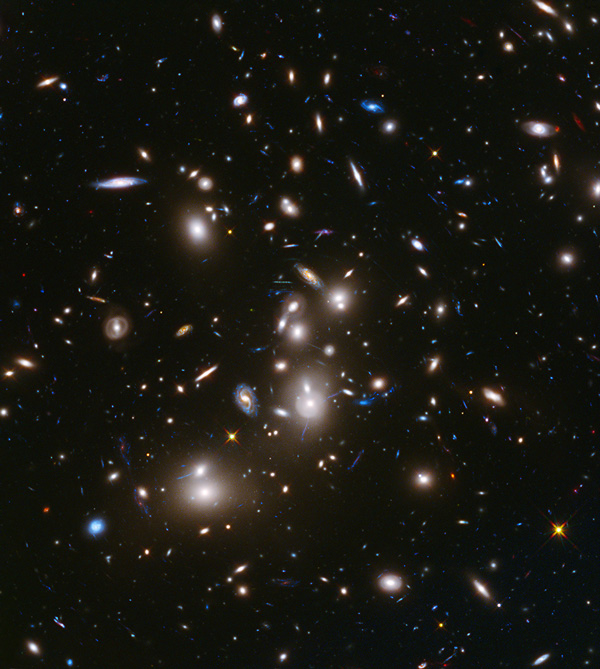
This long-exposure Hubble Space Telescope image of massive galaxy cluster Abell 2744 is the deepest ever made of any cluster of galaxies. Abell 2744, located in the constellation Sculptor, appears in the foreground of this image. It contains several hundred galaxies as they looked 3.5 billion years ago. (NASA/ESA/STScI)
Among the exciting programs we heard about during the review, one that stayed with me as the most compelling, ambitious, and potentially impactful was the HST Frontier Fields (HFF) program. HFF looks to leverage gravitational lensing from massive galaxy clusters to reach into the high-redshift Uuniverse and study the time when galaxies like ours were still forming. (A short aside: galaxy clusters are the most massive bound structures in the universe, and their enormous gravity bends and magnifies the light from much more distant sources—making them visible to observers.) The first field observed in the HFF program was the field surrounding the massive cluster Abell 2744, and three of the six HFF fields target "Abell" clusters.
So where does the odd-sounding name Abell 2744 come from anyway?
George Abell was a Caltech Astronomy graduate student in the mid 1950s, and a member of the National Geographic Society – Palomar Observatory Sky Survey (POSS I) team using the Palomar 48-inch Schmidt telescope (now the Samuel Oschin Telescope). Galaxy clusters such as Virgo, Fornax, and Coma were known in the nearby universe, but Abell's Ph.D. (1957) work focused on the identification and study of a large sample of galaxy clusters in POSS data, and he published his catalog of rich Northern Hemisphere galaxy clusters that same year. Abell's study of galaxy clusters was compelling in its own right—framed in a modern context these clusters are tracers of massive structure formation thought to be seeded by enormous dark matter halos. What Abell could not have known is the arc of his work would directly enable the study of cosmology and galaxy formation at the frontiers of our observational capabilities. This deep connection between Abell's work and the current frontiers of observational cosmology is but one facet of Palomar's rich scientific legacy: an early vision among Palomar astronomers that emphasized both detailed studies with the Hale and reconnaissance with the Oschin. In its present portfolio Palomar builds on both of these traditions every clear night, a point I mean to return to in our Fall 2015 newsletter.
Friends of Palomar Observatory: Activities for the Year
At Palomar College Planetarium on April 25, Dr. Shri Kulkarni, Director of Caltech Optical Observatories, gave a presentation concerning developments surrounding the creation of the Zwicky Transient Facility at Palomar Observatory. That evening, Mark Lane, Professor of Astronomy at Palomar College, also provided a planetarium show. Fifty people from the Friends of Palomar Observatory, the docents, and the Observatory staff attended this remarkable event.
Additional activities are being planned for the coming season. Three events are presently either confirmed or in the process of being scheduled.
First, we have been invited by the staff at Mt. Wilson to take a special two-hour tour of Mt. Wilson Observatory on June 27 starting at 11:00 am. We have been asked, however, to limit our group to 30 people. The tour is not yet full but, if you wish to attend, please email me as soon as possible with an RSVP to sbf [at] astro.caltech.edu. I will try to help arrange carpools if you wish.
Please be aware that there is a great deal of walking on this tour.
If you will be driving to Mt. Wilson, you will need a forest service parking permit. If you do not have a parking permit, a day permit may be purchased on the mountain at the Cosmic Café.
The staff at Mt. Wilson has asked that, in the event you wish to purchase a lunch from the Cosmic Café, you pre-order it. Information about ordering a lunch may be found here.
Maps and other information regarding Mt. Wilson Observatory are available at their website.
A second Friends of Palomar Observatory event is being planned for a Saturday evening at the end of July or perhaps early in August. We will be having a speaker from Caltech or other institution who will talk about an aspect of the research being done at the Observatory. After the presentation, the docents will hold a star party out behind the Outreach Center.
I will send out a notice when a date is set.
Finally, a third event is planned for a weekend in late October. We are going to have what is being termed an “intimate” tour. I don’t yet know the details of this tour but the idea is that we will get to see and do things at the Observatory that are not normally part of the public tours.
Again, I will send out an email to you all when we set a date.
And one more thing: Occasionally we will be holding afternoon cookouts on weekends at the Outreach Center following the regular public tours. Burgers and hot dogs and salad and popcorn and a movie—we had a “Burger Bash” here a few weeks ago and there was a great turn out. All of the members of the Friends of Palomar Observatory are invited to these cookouts and I’ll write to you when we schedule the next one.
If you need a brat in the wurst way, come up and join us!
- Steve Flanders
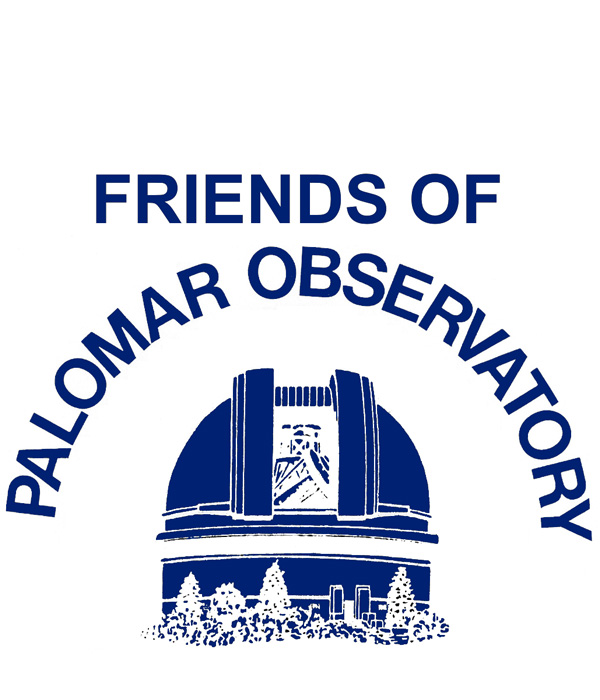
Questions? We've answered many common visiting, media, and academic questions in our public FAQ page.
Please share your feedback on this page at the
COO Feedback portal.
Big Eye 10-1
Last updated: 14 May 2015 AFB/SBF/ACM

